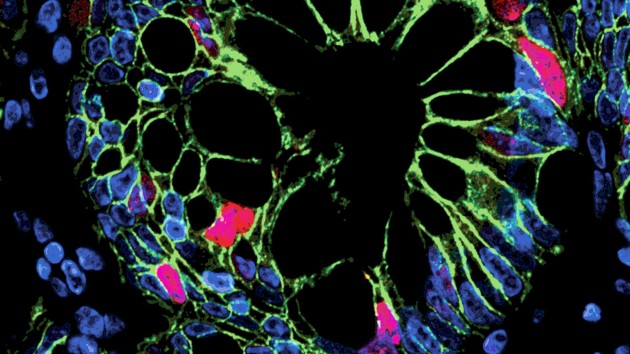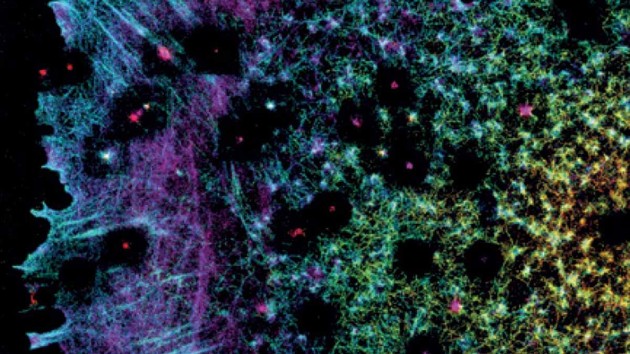Milestone |
Collections
Filters
-
Collection Type
-
-
Collection |
 The golden anniversary of eukaryotic transcription
The golden anniversary of eukaryotic transcription
The discovery of three DNA-dependent RNA polymerases (Pol I, Pol II, Pol III) in 1969 revolutionized our understanding of gene regulation.
Image: V. Summersby -
Focus |
 Methylation in biology
Methylation in biology
DNA, RNA and proteins are dynamically modified by methylation to regulate gene expression and protein function. Methylation dysregulation is associated with cancer and other diseases. The Reviews in this focus issue showcase the latest understanding of the mechanisms and roles of methylation in animals and of its clinical relevance.
Image: Vicky Summersby -
Collection |
 The 3D genome
The 3D genome
This collection includes recent articles from across the Nature group of journals and showcases both the latest advances in the methodologies used to study genome organization, and our recent understanding of how genome organization and nuclear architecture regulate gene expression, cell fate and cell function in physiology and disease.
Image: V. Summersby -
Series |
 Cell death and autophagy
Cell death and autophagy
In this article series, Nature Reviews Molecular Cell Biology looks at the progress that has been made in our molecular understanding of different modes of cell death and of autophagy as both a survival and death mechanism.
Image: Vicky Summersby -
Collection |
 Stem cells from development to the clinic
Stem cells from development to the clinic
Stem cells are well on their way into the clinic and can be used in a variety of applications, such as disease modelling, drug screening and for regenerative medicine. This collection showcases research articles, reviews and protocols from across the Nature journals to highlight the striking advances made in basic and translational stem cell research.
Image: Miguel Quiros and Asma Nusrat -
Collection |
 Super-resolution microscopy
Super-resolution microscopy
Popularization of super-resolution imaging techniques has allowed cell biologists to probe cell structure and function in previously unattainable detail. These methodologies continue to evolve, with new improvements that allow tailoring the available techniques to a particular need and application. This collection showcases primary research articles, reviews and protocols and highlights these recent developments by exemplifying the new, interesting applications of super-resolution microscopy as well as related tool development.
Image: Bertocchi et al., Nature Cell Biology volume 19, pages 28–37 (2017). -
Focus |
 Mechanobiology
Mechanobiology
This Focus issue includes Review articles and comments that discuss how mechanical forces are transduced into the cell, including into the nucleus, to control gene expression and to regulate morphogenesis, tissue regeneration and tumorigenesis. Also discussed is the therapeutic potential of modulating mechanotransduction with the use of synthetic matrices.
Image: Vicky Summersby -
Collection |
 mRNA splicing: 40 years on
mRNA splicing: 40 years on
A collection of recent review and research articles from the Nature journals on the mechanisms, regulation and functions of mRNA splicing.
Image: Vicky Summersby -
Collection |
 Protein-lipid interactions
Protein-lipid interactions
Cellular lipid bilayers and membrane proteins are highly organised and tightly regulated. Our current understanding of protein—lipid interactions is largely based on advanced biophysical or structural studies of a few prototypes. Although these methods are excellent, there is a need for more generic approaches that can be scaled up to identify and characterise more interactions. This collection, by Nature Protocols and Nature Reviews Molecular Cell Biology includes Reviews of protein—lipid interactions and the technologies that enable the study of these interactions in a systemic level, and step-by-step Protocols for such techniques.
Image: Vicky Summersby -
Focus |
 DNA damage repair
DNA damage repair
DNA lesions are repaired by a plethora of cellular processes, together constituting the DNA damage response, which is crucial for the maintenance of genomic integrity. It is becoming increasingly clear that different repair pathways can crosstalk, owing to the capacity of certain proteins to function in the signalling and repair of different DNA lesions. Furthermore, DNA repair factors and pathways are intricately connected with cellular processes such as DNA replication, transcription and protein post-translational modifications.
Image: Nicola Hawes -
Collection |
 The Epitranscriptome
The Epitranscriptome
Welcome to 'The Epitranscriptome', an article collection from various Nature journals highlighting the role of mRNA modifications in RNA fate and gene expression.

 Nature Milestones in Antisense RNA
Nature Milestones in Antisense RNA